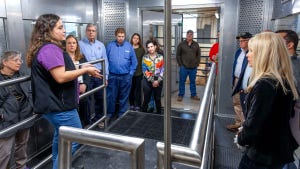During House Ag hearing, witness testifies about how animal and public health sectors need more integration.

Since the events of 2001, the agricultural sector has made great strides in preparing for challenges posed by a natural or intentional introduction of a biological event. But animal agriculture needs to more closely integrate with the public health sector as the nation is still “woefully underprepared” for the next big threat, according to Dr. Tammy Beckham.
Testifying before a House Agriculture subcommittee Nov. 3, Beckham, dean of the college of veterinary medicine at Kansas State University, said as demonstrated recently during the porcine epidemic diarrhea virus (PEDV) in swine herds, highly pathogenic avian influenza (HPAI) in poultry populations and last the Ebola virus (EBOV) disease in the public health sector, the approach has been mostly reactive and less proactive when it comes to preparing for the next emerging threat.
Beckham said actions must be taken immediately to address gaps in the current biodefense system. In her written testimony she shared that there is increased movement of people, animals, plants and products globally, increasing the potential for disease threats to emerge. It is estimated that on any given day, approximately 1 million swine and 400,000 cattle are in transit to the next location in the production system at any given time during the day.
She shared that during the 2014 Ebola virus outbreak in the U.S. the meaning of the term “One Health” took on a new significance and some of the greatest lessons were learned and largest gaps in biodefense highlighted. The One Health Initiative has the goal of uniting human and veterinarian medicine by expanding interdisciplinary collaborations and communications.
Beckham cited that it has been estimated that over 75% of all emerging pathogens are zoonotic and that zoonotic pathogens are twice as likely to be associated with an emerging disease as non-zoonotic pathogens. She said that as most diseases are zoonotic, it’s important to develop countermeasures that are effective and stamp out the diseases in the animal population before it gets into humans.
“All too often we have been very reactive,” she said. By focusing on preparedness rather than being reactive it is going to require the human health component see the animal health component as just as important.”
Recent statistics indicate that during the FY2014, 61% of federal funding for biodefense was allocated to the Department of Health and Human Services (DHHS). By comparison, 1% of federal government funding for biodefense was allocated to the U.S. Department of Agriculture for agricultural biodefense.
She testified that the formation of a biodefense panel would allow for greater coordination and provide a platform for the development of a more cohesive and collaborative national biodefense strategy. Furthermore, a leader and/or council that could assemble a robust team of federal and industry partners could help lower barriers that prevent our ability to truly implement the “One Health” initiative.
Barriers to this could be overcome with time, collaboration, interdisciplinary programs and budgets to support and incentivize working together to prepare the U.S. for the next emerging disease event.
Overall she said in order to mitigate damages from animal diseases that harm the nation’s food supply a robust biosurveillance system and early detection need to be in place. Other necessities include investing in the National Animal Health Laboratory Network, coordinating better with the public health network, investing in more vaccines and research on the upfront end and training first responders and working with state and local entities to help the industry better prepare for the unknown threats ahead.
“We’re not failing,” she said of the progress made on the front. “We just need a more coordinated approach and more resources to get us there faster.”
About the Author(s)
You May Also Like



.png?width=300&auto=webp&quality=80&disable=upscale)

